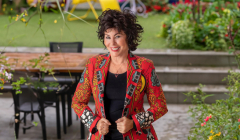
‘Being frazzled in the workplace has been dangerously normalised’
Comedian and actress Ruby Wax, Founder of mental health charity Frazzled, on taking stress seriously.

As Getty Images celebrates its 25th anniversary, the company is focusing on helping brands navigate an ever-crowded visual landscape, through the power of visual language and storytelling.

“We are evolving beyond trends to focus on and measure the forces that affect these trends.” Jacqui Bourke, Senior Manager Creative Insights at Getty Images unveiled the “next generation of creative insights.” Insights which Getty are calling ‘Visual GPS’ which were launched at an event held at the Royal Academy of Arts in London.
As Getty celebrates its 25th anniversary, the company is focusing on helping brands navigate an ever-crowded visual landscape, through the power of visual language and storytelling. Ken Mainardis, Senior Vice President, Content at Getty explained that Visual GPS was designed as the next step “to drive change to create a more representative visual landscape.”
Getty partnered with YouGov to survey 10,000 people in 13 languages across 26 countries, which, when used in conjunction with search data from Getty’s sites and internal creative insights from the expert creative visual team combine to create the insights underpinning Visual GPS.
Visual GPS is based around the belief that there are four macro forces driving visual conversation and consumer decision making: realness, wellness, technology and sustainability. These forces are now the focus because they are continuously evolving as consumer mindset simultaneously evolves.
Bourke explained how trust, tolerance and transparency are paramount to consumers; a shift which is underpinning the ‘realness’ trend. She then introduced a number of Getty collections that are championing this force, from Project #ShowUs with Dove and girlgaze to the Disability Collection and Masculinity Undone.
Dr Helena Lewis-Smith, a health psychology expert from the University of Bristol, added that the shift to ‘realness’ reflects the long overdue acceptance of our differences. Lewis-Smith pointed out that “people aren’t passive consumers; they’re active.” As such brands should be “connecting with consumers on a deeper level so they feel seen,” she added.
When it came to Wellness, Bourke pointed out that it can mean different things to different people. She pointed to the fact that wellness can be about coming together to celebrate the good things in life. This is something the award-winning spoken word artist and author Sophia Thakur wholeheartedly believes in. She explained that “wellness is overall fulfilment.” Thakur urged brands to do more than advocate for typically accepted wellness solutions like yoga and instead “promoting the visuals that demonstrate the day to day things you can do for your wellness and mental health.” Ultimately, she says, “lean in to what brings you joy.”
Technology is a force that Bourke believes is creating the greatest amount of “dynamic tension,” in the industry. Rohit Talwar, CEO at Fast Future, believes is the distinct lack of education about what technology can do, which fuels the fear of it. “Technology is moving faster than our understanding of it,” he explained, highlighting that the “challenge is about helping brands raise their digital literacy.” Talwar believes that we need to have a true understanding of what technology can do: “If you understand the possibilities, you can make decisions.”
The final force explored was Sustainability, a universal force, which according to Bourke stretches across generations, gender and regions; “it has intersectional desire,” she added. Toby Smith, the Climate Visuals Programme Lead at Climate Outreach explored how the growth of awareness around sustainability and its impacts has grown in recent years. As an environmental photographer, Smith believes that “intelligent visual messaging can be cross cutting,” and can help to quell the fear and combat the apathy that so many feel in this space.
Visit the Visual GPS website to download the full report.


All photography © Getty Images
Looks like you need to create a Creativebrief account to perform this action.
Create account Sign inLooks like you need to create a Creativebrief account to perform this action.
Create account Sign in